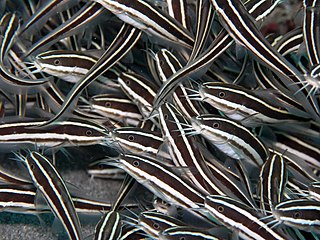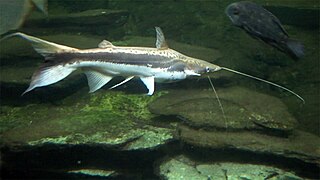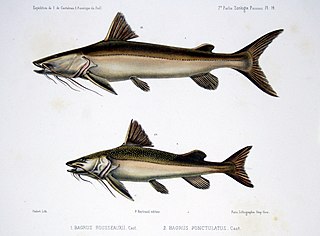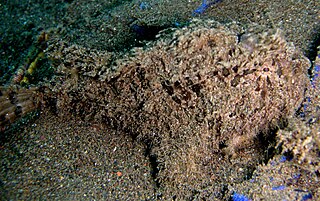
The Mochokidae are a family of catfishes that are known as the squeakers and upside-down catfish. There are nine genera and about 200 species of mochokids. All the mochokids are freshwater species originating from Africa.

The eeltail catfish are a family (Plotosidae) of catfish whose tails are elongated in an eel-like fashion. These catfishes are native to the Indian Ocean and western Pacific from Japan to Australia and Fiji. The family includes about 41 species in 10 genera. About half of the species are freshwater, occurring in Australia and New Guinea.

The stream catfishes comprise the family Akysidae of catfishes.

Erethistidae are a family of catfishes that originate from southern Asia. It includes about 45 species.

The smoothback angelshark is an angelshark of the family Squatinidae found in the eastern Atlantic and Mediterranean.

The Arabian carpetshark is a species of carpet shark in the family Hemiscylliidae, inhabiting coral reefs and other shallow coastal habitats from the Persian Gulf to India. Reaching 78 cm (31 in) long, this shark is characterized by a slender, plain brown body, and by two dorsal fins with straight trailing margins and the second smaller but longer-based than the first. The Arabian carpetshark feeds on bony fishes and invertebrates. Reproduction is oviparous with an annual cycle; females deposit egg capsules four at a time and the young hatch after 70–80 days. This small shark is often captured as bycatch but rarely used by humans. It has been assessed as Near Threatened by the International Union for Conservation of Nature (IUCN), as there is increasing fishing pressure and habitat degradation within its range. It does well in aquariums and has been bred in captivity.
Squalus nasutus, the western longnose spurdog, is a dogfish of the family Squalidae, found on the continental shelf off the northwest and southwest coasts of Western Australia, at depths between 300 and 510 m. Its length is at least 55 cm.

Sorubim is a small genus of long-whiskered catfish native to tropical South America. A number of characteristics allows the differentiation of each species in the genus. Sorubim species are important food fish in South America and are highly significant to fisheries of some areas; however, harvests of these fish are not identified as much as other, more popular food fishes such as Colossoma, Arapaima, and Brachyplatystoma. Some species of this family are popular aquarium fish.

Brachyplatystoma is a genus of catfish from the family Pimelodidae. As the occasionally used common name goliath catfishes indicates, this genus includes some of the largest species of catfish, including the piraíba, B. filamentosum, which reaches up to the region of 3.6 metres (12 ft) in length. Brachyplatystoma are found in the Amazon and Orinoco basins, and other tropical freshwater and brackish habitats in South America. Some species are migratory. These fish are important as food fish and, to some extent, aquarium fish.

Bagrichthys is a genus of bagrid catfishes.
Rhynchodoras is a small genus of thorny catfishes native to South America. Rhynchodoras is closely related to Rhinodoras and Orinocodoras.

Sisor is a genus of catfishes native to Asia.
Breitensteinia is a genus of catfishes of the family Akysidae. It includes three species.

Plotosus is a genus of eeltail catfishes native to the Indian Ocean, the western Pacific Ocean and New Guinea.

The bayad, is a species of bagrid catfish from Africa.
The Somalia catfish is a species of catfish in the family Bagridae. The Somalia catfish is native to the Jubba River in Somalia.

The Butler's frogfish or blackspot anglerfish, Tathicarpus butleri, is a rare species of frogfish in the family Antennariidae. The only member of its genus, this species is the most derived member of its family and represents a separate lineage from all other frogfishes, leading to some consideration of it being placed in its own family. It is found off the southern coast of New Guinea, and along the coasts of Western Australia to 33° S latitude, the Northern Territory, and Queensland to 22° S latitude. A benthic species, it inhabits inshore tropical waters and coral reefs to a maximum depth of 145 m (476 ft), though most are found shallower than 45 m (148 ft). Its specific epithet is after its discoverer Dr. Graham Butler.

Plotosus lineatus, common name striped eel catfish, is a species of eeltail catfishes belonging to the family Plotosidae.

Lutjanus carponotatus, the Spanish flag snapper, stripey snapper, dusky-striped sea-perch, gold-banded sea perch, gold-stripe sea-perch, striped seaperch or stripey seaperch, is a species marine ray-finned fish, a snapper belonging to the family Lutjanidae. It is native to the western Pacific and Indian Oceans, from India to northern Australia.

Paraplotosus butleri, commonly known as the sailfin catfish, is a species of catfish in the family Plotosidae. This fish is found in coastal reefs off northern Australia in the western Indo-Pacific Ocean. It grows up to about 32.5 centimetres (12.8 in) SL.















